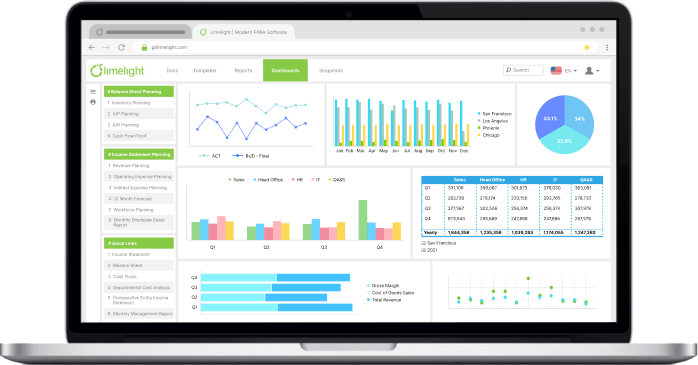Rolling forecast software helps you evolve past static budgeting to a model that enables your FP&A team to make decisions smarter, faster, and with real-time data.
Once seen as complex and difficult, transitioning has never been easier thanks to the wealth of forecasting software available on the market. Even with these advances, however, statistics suggest that one in five organizations abandon the shift to rolling forecasts due to the added complexity vs static budgeting.
Related Reads: Top 10 Financial Forecasting Software for 2025
But these organizations are then missing on the ability to forecast and budget more accurately, according to this IBM study.
Switching to rolling forecasts unlocks your team’s potential to be real drivers of value at your organization, able to forecast with far more accuracy and incorporate real-time data into their analysis versus using lagging numbers. In other words, it’s far more difficult for you and your finance team to reach your full potential without the use of rolling forecasts.
The good news is that the process of switching over isn’t daunting - with the right mindset and tools, you can access more accurate forecasting faster and more easily than you may think.
Why Rolling Forecast Software Is the Smart Move?
Our current economic environment moves at a digital pace – data can be collected, analyzed, and aggregated in a manner of seconds, something that formerly took whole teams of finance professionals days, weeks, or even months to accomplish.
Operating off a static budget alone leaves your organization at a severe disadvantage – especially when you consider just how rapidly modern markets are prone to seismic shifts.
From COVID lockdowns to fluid interest rates to supply chain aftershocks, being adaptable is critical to any planning activities that your FP&A team engages in. That’s why a dynamic forecasting model – rolling forecasts – are the only suitable option to keep up with the modern pace of business.
Compared to static budgets, rolling forecasts help drive real value for your organization. First you get to re-forecast every month or quarter, increasing your agility and unlocking the ability to course correct should markets shift. When equipped with the right tools, rolling forecasts can also be leveraged to develop scenario modeling, i.e. what to do if a new market opportunity emerges, economic conditions change, etc.
Scenario modeling can inform all manner of decisions and reforecast, including:
- Optimal time to launch a product
- Which new markets to enter
- Where to allocate resources internally
- Risk management
And more.
Here's the best part: you can accomplish all of the above faster, easier, and with increased accuracy by using forecasting software.
Why the Static Budgeting Processes Is Going the Way of the Dodo?
The average company will take anywhere from 25-56 days to complete a budget.
This huge time sink necessarily saps your finance team’s time and energy, preventing them from performing more high value FP&A tasks like in-depth analysis and financial modeling.
Worse yet, most of the data that’s used in static budget reports is already out of date by the time it’s ready to be shared.
And perhaps most alarming is that, if you’re stuck on Excel spreadsheets as your source of historical data, then you’re at risk of numerous errors and pitfalls that could cost your business hundreds, thousands, millions, or billions of dollars, depending on your company’s size.
How Rolling Forecasting Software Cleans Up This Mess?
If strategic planning is the goal, then your best bet is to move to a rolling forecast model.
Accurate rolling forecasts have been shown to be a strong driver of overall corporate performance.
Aberdeen Group found that companies with finance automation and rolling forecast software are:
- 4.4x to be able to perform “what-if” analysis
- 2.6x to offer business users self-serve reports
- 2.5x to assign workflows to guide users through the planning process
- 2.5x to measure their forecasting accuracy
- 1.5x to maintain a complete, auditable record of previous forecasts
- 2.4x to perform multi-dimensional reporting
And more. This has a real impact on revenue: that same study found that companies using rolling forecasts showed a 43% increase in revenue growth over a 24-month period versus companies that didn’t use rolling forecasts.

How to Implement Effective Rolling Forecasts at Your Business?
Rolling forecasts aren’t prescient – they can’t predict the future with nearly 100% accuracy.
Instead, these forecasts enable you to monitor and improve performance and plans as your fiscal year progresses. This allows you to leverage timely, driver-based data during planning, enabling that flexibility we mentioned earlier.
While your numbers won’t ever be 100% accurate, you can calibrate your process over time to increase the accuracy of your forecasts. Some useful tactics that will help you achieve higher accuracy include:
- Prepopulating forecasts with budget numbers from previous years, developing a data-backed starting point
- Tie in business managers’ compensation to forecasting accuracy, though ensure that this doesn’t necessarily lead to simplified (easier to predict) forecasts
- Revisit, revise, retool – hone the process until gaps, missteps, and inaccuracies are identified and eliminated. Automation can be a great deal of help in this area as well!
Be Disciplined in What You Track
You can’t track everything all the time – there’s simply too much data and too many unpredictable variables (competition, geopolitical issues, economic conditions, etc.).
Instead, you need to be disciplined in what you track via rolling forecasts.
This means being selective in the KPIs you measure and analyze.
Complete forecasts will take both internal and external factors into account – many companies only consider internal financial factors when forecasting.
You can also identify variances, then dig down into them to explore why they happened – that analysis can pay huge dividends to your business if anomalies or inaccuracies are detected.
Revenue Planning, Cashflow Forecasting - Do It All with the Right Rolling Forecast Software
Rolling forecasts and the future of FP&A are in cloud FP&A software.
An FP&A platform that leverages the cloud, automation, machine learning, a centralized database (single source of truth) that pulls numbers in real time from your ERP, etc.,
An FP&A platform is also crucial when performing cashflow forecasting - something that is particularly important for VCs (for instance, determining how long a startup can keep the doors open) and particularly difficult for nonprofits (juggling multiple sources of funding from all over the country or even the world and making projections can be daunting task).
Workforce planning is also simplified with FP&A software that accounts for changes in status (and accompanying benefit package differences), raises, bonuses, etc.
You can even use this software to help with revenue planning surrounding new product launches, seasonal changes, etc.

Limelight FP&A Cloud Software is here to help you make all the above possible - learn more here.








.png?width=381&height=235&name=linkedinreal%20(27).png)
